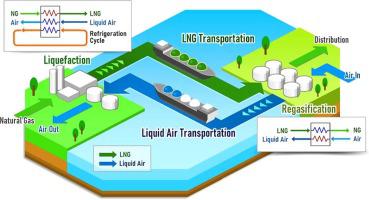当前位置:
X-MOL 学术
›
Energy Convers. Manag.
›
论文详情
Our official English website, www.x-mol.net, welcomes your feedback! (Note: you will need to create a separate account there.)
Liquefied natural gas supply chain using liquid air as a cold carrier: Novel method for energy recovery
Energy Conversion and Management ( IF 10.4 ) Pub Date : 2021-01-01 , DOI: 10.1016/j.enconman.2020.113611 Jinwoo Park , Fengqi You , Haneul Mun , Inkyu Lee
Energy Conversion and Management ( IF 10.4 ) Pub Date : 2021-01-01 , DOI: 10.1016/j.enconman.2020.113611 Jinwoo Park , Fengqi You , Haneul Mun , Inkyu Lee

|
Abstract A novel concept for energy integration across the liquefied natural gas (LNG) supply chain is proposed by using liquid air as a medium for recycling cold energy. This allows the natural gas liquefaction and LNG regasification stages to be integrated despite the long distance between the two sites. LNG carrier ship is used to convey liquid air on its return journey when it would otherwise be empty. On its return to the liquefaction site, the cold energy stored in the liquid air can then be harnessed to liquefy natural gas for transportation. At the regasification site, LNG cold energy is used to regenerate liquid air for the ship’s return journey. In this way, LNG cold energy, which is generally wasted, is used in the proposed LNG supply chain. As a result, the energy requirement for liquefying natural gas can be reduced significantly, and the waste LNG cold energy recovered. The proposed mixed refrigerant with liquid air (MRLA) process design has an energy requirement of 865.82–917.20 kJ/kg-LNG, which is 26.1–30.2% lower than that for a single mixed refrigerant (SMR) process. The proposed process exhibits even lower energy requirements with a much lower capital cost when compared to the propane precooled mixed refrigerant (C3MR) process (974.0–992.0 kJ/kg-LNG), known as one of the most efficient natural gas liquefaction processes. The results of exergy analysis for the proposed processes show that the cold energy supply from liquid air achieves a reduction in the energy requirement. Furthermore, a techno-economic study reveals that an 18.6–22.6% reduction in total costs for LNG liquefaction can be achieved and economically attractive to be implemented in commercial natural gas liquefaction plants, given the minimal infrastructural changes necessary. Overall using this novel approach, the liquefaction and regasification stages are integrated despite the physical separation of the individual processes over long distances. This significantly enhances the LNG supply chain by not only improving its energy performance but also contributes to the utilization of cold energy by using the empty LNG ship on the return journey.
中文翻译:

以液态空气为冷载体的液化天然气供应链:能量回收的新方法
摘要 通过使用液态空气作为循环冷能的媒介,提出了跨液化天然气 (LNG) 供应链的能源整合的新概念。这使得天然气液化和 LNG 再气化阶段得以整合,尽管两个地点之间的距离很远。LNG 运输船用于在回程时输送液态空气,否则它会是空的。在返回液化现场后,储存在液态空气中的冷能可用于液化天然气进行运输。在再气化现场,LNG冷能用于为船舶回程再生液态空气。这样,在提议的 LNG 供应链中使用了通常被浪费的 LNG 冷能。因此,液化天然气的能源需求可以显着降低,以及回收的废弃LNG冷能。拟议的液态空气混合制冷剂 (MRLA) 工艺设计的能量需求为 865.82–917.20 kJ/kg-LNG,比单一混合制冷剂 (SMR) 工艺低 26.1–30.2%。与丙烷预冷混合制冷剂 (C3MR) 工艺 (974.0–992.0 kJ/kg-LNG) 相比,该工艺表现出更低的能源需求和更低的资本成本,丙烷预冷混合制冷剂 (C3MR) 工艺被称为最有效的天然气液化工艺之一。拟议过程的火用分析结果表明,来自液态空气的冷能供应实现了能源需求的减少。此外,一项技术经济研究表明,18.6-22. 考虑到必要的最小基础设施变化,LNG 液化总成本可以降低 6%,并且在商业天然气液化工厂中实施具有经济吸引力。总体而言,使用这种新颖的方法,尽管各个过程长距离物理分离,但液化和再气化阶段是集成的。这显着增强了 LNG 供应链,不仅提高了其能源性能,而且还通过在回程中使用空的 LNG 船来促进冷能的利用。
更新日期:2021-01-01
中文翻译:

以液态空气为冷载体的液化天然气供应链:能量回收的新方法
摘要 通过使用液态空气作为循环冷能的媒介,提出了跨液化天然气 (LNG) 供应链的能源整合的新概念。这使得天然气液化和 LNG 再气化阶段得以整合,尽管两个地点之间的距离很远。LNG 运输船用于在回程时输送液态空气,否则它会是空的。在返回液化现场后,储存在液态空气中的冷能可用于液化天然气进行运输。在再气化现场,LNG冷能用于为船舶回程再生液态空气。这样,在提议的 LNG 供应链中使用了通常被浪费的 LNG 冷能。因此,液化天然气的能源需求可以显着降低,以及回收的废弃LNG冷能。拟议的液态空气混合制冷剂 (MRLA) 工艺设计的能量需求为 865.82–917.20 kJ/kg-LNG,比单一混合制冷剂 (SMR) 工艺低 26.1–30.2%。与丙烷预冷混合制冷剂 (C3MR) 工艺 (974.0–992.0 kJ/kg-LNG) 相比,该工艺表现出更低的能源需求和更低的资本成本,丙烷预冷混合制冷剂 (C3MR) 工艺被称为最有效的天然气液化工艺之一。拟议过程的火用分析结果表明,来自液态空气的冷能供应实现了能源需求的减少。此外,一项技术经济研究表明,18.6-22. 考虑到必要的最小基础设施变化,LNG 液化总成本可以降低 6%,并且在商业天然气液化工厂中实施具有经济吸引力。总体而言,使用这种新颖的方法,尽管各个过程长距离物理分离,但液化和再气化阶段是集成的。这显着增强了 LNG 供应链,不仅提高了其能源性能,而且还通过在回程中使用空的 LNG 船来促进冷能的利用。


























 京公网安备 11010802027423号
京公网安备 11010802027423号